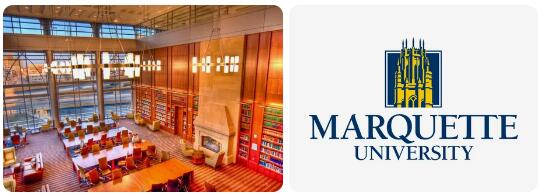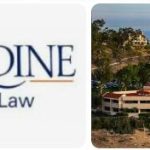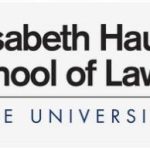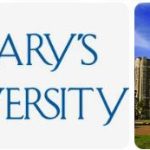Marquette University Law School was established in 1908 and was the first law school in the state of Wisconsin. It was founded by members of the Milwaukee Bar Association and had a mission to provide an education in the law that would be accessible to people of all backgrounds. The school has since grown with an enrollment of over 600 students and is one of the top-ranked law schools in the Midwest. Over its long history, Marquette Law School has been home to many notable alumni, including five Wisconsin Supreme Court justices, three United States Circuit Judges, and two U.S. Attorneys General. The school has also produced several prominent legal scholars who have shaped American jurisprudence through their work on important cases such as Brown v. Board of Education and Miranda v. Arizona. Marquette Law School continues to strive for excellence and is proud to offer a quality legal education with a focus on service, ethics, and justice for all.
Marquette University Law School is located in the state of Wisconsin. As one of the leading law programs, Marquette University Law School has a high average LSAT score of 155-159 when recruiting new students. As a return, the median starting salary for law graduates reaches $56,325 per year. See the following table for detailed admissions information and career profiles of Marquette University Law School.
Admissions: Marquette University
Marquette University Law School is one of the top law schools in the country. The school has an acceptance rate of 48%. This means that out of every 100 applicants, 48 are accepted. The median GPA for accepted students is 3.7 and the median LSAT score is 153. In addition, Marquette Law School has a student-faculty ratio of 10:1, which allows for individualized attention. The school also boasts a 95% bar passage rate, which indicates that its graduates have been highly successful in passing the bar exam. Furthermore, Marquette Law School provides several financial aid options to help students pay for tuition and other costs associated with attending law school. These include merit-based scholarships, grants, and loans from private lenders and government sources. Additionally, the school offers a wide range of academic support services to ensure that students get the most out of their education. This includes career counseling and mentorship programs as well as internships and externships with local organizations.
| Fall 2019 Admissions and Enrollment Statistics | |
|---|---|
| Total number of full- and part-time applicants | 2,084 |
| Total number of full- and part-time acceptances | 927 |
| Overall acceptance rate | 44.5% |
| Total number of full- and part-time first-year students enrolled | 219 |
| Number of full-time program applicants | 1,905 |
| Number of full-time program acceptances | 868 |
| Full-time acceptance rate | 45.6% |
| Number of first-year full-time students enrolled | 185 |
| Number of part-time program applicants | 179 |
| Number of part-time program acceptances | 59 |
| Part-time acceptance rate | 33.0% |
| Number of first-year part-time students enrolled | 34 |
| Fall 2019 GPA and LSAT Scores | |
| 25th-75th percentile GPA scores for all students | 3.07-3.61 |
| 25th-75th percentile LSAT scores for all students | 154-159 |
| 25th-75th percentile undergraduate GPA for full-time students | 3.09-3.61 |
| 25th-75th percentile LSAT scores for full-time students | 155-159 |
| 25th-75th percentile undergraduate GPA for part-time students | 2.88-3.6 |
| 25th-75th percentile LSAT scores for part-time students | 151-158 |
Careers: Marquette University
| Bar Statistics (Winter and Summer 2018 administrations) | |
|---|---|
| State where the greatest number of first-time test takers took the bar | WI |
| School’s bar passage rate for first-time test takers | 100.0% |
| Statewide bar passage rate for first-time test takers | 91.9% |
| Class of 2018 Graduates | |
| Total graduates | 195 |
| Graduates employed at graduation | 61.0% |
| Graduates known to be employed nine months after graduation | 92.8% |
| Starting Salaries of 2018 Graduates Employed Full-time | |
| 25th percentile private sector starting salary | $48,000 |
| Median private sector starting salary | $56,325 |
| 75th percentile private sector starting salary | $107,000 |
| Percent in the private sector who reported salary information | 76% |
| Median public service starting salary | $49,000 |
| Areas of Legal Practice (Class of 2018) | |
| Percent employed in academia | 3.0% |
| Percent employed in business and industry | 14.0% |
| Percent employed in government | 10.0% |
| Percent employed in all judicial clerkships | 4.0% |
| Percent employed in law firms | 64.0% |
| Percent employed in public interest | 5.0% |
| Percent employed in an unknown field | 0.0% |
| Percent employed in a judicial clerkship by an Article III federal judge | 1.0% |
| 2018 Graduates Employment Location | |
| Graduates employed in-state | 74% |
| Graduates employed in foreign countries | 1% |
| Number of states where graduates are employed | 16 |
| New England (CT, ME, MA, NH, RI, VT) | 0.0% |
| Middle Atlantic (NY, NJ, PA) | 0.6% |
| East North Central (IL, IN, MI, OH, WI) | 80.2% |
| West North Central (IA, KS, MN, MO, NE, ND, SD) | 2.3% |
| South Atlantic (DE, DC, FL, GA, MD, NC, SC, VA, WV) | 11.3% |
| East South Central (AL, KY, MS, TN) | 0.0% |
| West South Central (AR, LA, OK, TX) | 2.3% |
| Pacific (AK, CA, HI, OR, WA) | 1.7% |
| Mountain (AZ, CO, ID, MT, NV, NM, UT, WY) | 1.1% |
| Employment location unknown | 0.0% |
| Career Services | |
| (Data appear as originally submitted by this school) | |
| Career services operations | The Career Planning Center offers students and alumni the following: individual career planning and advising, fall and spring on-campus interview programs, a comprehensive resource library, interactive skills workshops, a monthly newsletter, career and job search-related speakers and panel discussions, mock interviews, online jobs bulletins, and an alumni network of career advisers. |
| Job Type | |
| Bar admission required or anticipated (e.g., attorney and corporate counsel positions, law clerks, judicial clerks) | 80.0% |
| J.D. preferred, law degree enhances position (e.g., corporate contracts administrator, alternative dispute resolution specialist, government regulatory analyst, FBI special agent) | 12.0% |
| Professional/other (jobs that require professional skills or training but for which a J.D. is neither preferred nor particularly applicable; e.g., accountant, teacher, business manager, nurse) | 7.0% |
| Nonprofessional/other (job that does not require any professional skills or training or is taken on a temporary basis and not viewed as part of a career path) | 1.0% |









